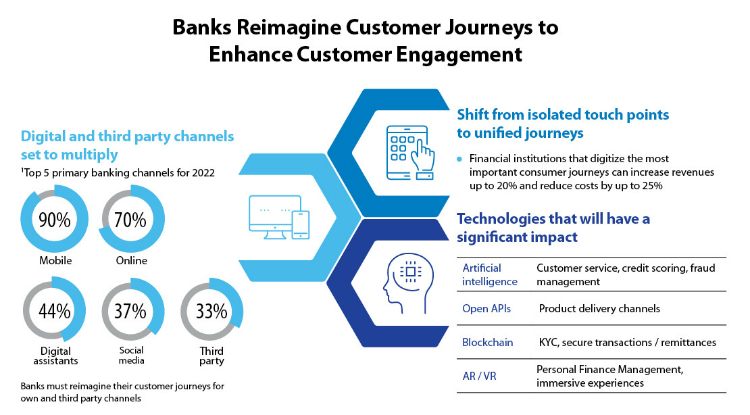The banking, financial services, and insurance (BFSI) industry are in a state of flux. Developments in financial technology, generational shifts among customers, and high incomes in the first quarter of 2021 have accelerated the use of new digital technologies and increased the need to explore new ways of communicating.
Here we look at how banks are reshaping the customer journey to increase customer engagement.

Banks already have mobile apps, and their use continues to grow steadily. However, these apps are limited in several ways. Often, apps can only be accessed on one or two channels; customers cannot continue a conversation across channels – switching from their mobile phone to a smart home center, for example.
Mobile apps often offer limited functionality, requiring users to go to a website or call a call center to complete a specific process. Combined with complex menu systems, hard-to-find information, and a lack of personalized financial advice, it is clear that change is needed.
Chatbots not only allow customers to process requests faster and more efficiently, but they also act as a listening channel from which we can get to know our customers better.
We learn more about our customers, their likes, dislikes, and changes to their immediate plans or circumstances with every conversation. This information allows us to provide a personalized service, such as recommending the product or service that best suits their situation.
Improving customer service efficiency, minimizing human error, and resolving customer queries more quickly can significantly impact operational costs. According to research by Juniper, the use of chatbots will save banks worldwide up to $7.3 billion by 2023. This equates to a saving of 862 million hours or nearly half a million labor years.
Such deployments are critical for financial firms to transform to compete with industry giants digitally.
Chatbot Use Cases in the Financial Industry
The rise of artificial intelligence (AI) chatbots in the financial sector shows how quickly the business landscape can change, even in traditionally conservative sectors. Here are several of the most successful uses of chatbots in the BFSI sector:
Enhance Customer Support
Chatbots for financial services can help customers with various financial transactions in a fun and secure way. From checking an account, reporting a lost card or payment, renewing insurance, or processing a refund, customers can complete simple tasks independently.
Provide Financial Advice
What if chatbots could not only handle all consumer queries but also give advice on their financial health? They could track their accounts, analyze their spending habits and recommend a budget or savings plan. In this way, they help users stay in control of their finances.
Prevent Fraud
Security and data protection is a concern for every business. But for banks and financial organizations, their reputation depends on it. Chatbots can effectively monitor and detect warning signs of fraudulent activity and alert customers and banks directly.
Manage Internal Operations
Chatbots provide employees with the proper support to speed up tedious and repetitive tasks and facilitate more complex and time-consuming back-office operations, such as managing internal records or training new employees.
Promotion and Cross-Selling
Banks, insurance companies, and financial institutions often offer a wide range of products and services.
AI chatbots can proactively suggest offers and services tailored to each user using all the data collected in previous conversations.
For example, if a customer regularly transfers money from a current account to a savings account, the bank only sees a single transaction; the customer’s needs are not understood.
But a simple conversational prompt from an intelligent virtual assistant, such as “Save for something nice? Can turn that transaction into a mortgage request, holiday insurance, or a car loan.
5 Key Features for a Banking Bot
You may think you already have a chatbot or virtual assistant, but most have limited capabilities and offer few features customers want.
These inadequate chatbots do not inspire the trust that a customer expects from their bank. Although the customer prefers a chatbot for various transactions, they end up talking to a live agent.
The ideal virtual assistant should function as a financial advisor and not as an FAQ chatbot. Above all, this means that the chatbot should know your customers, be an expert on your products and services, learn from accurate data and interact intelligently with users just as a human would.
A banking chatbot must have the following characteristics:
1. Conversational
The most natural form of human communication is language. Just being able to speak while interacting with a bot is something we all want to do. The frustration that arises when we talk to a chatbot that doesn’t understand us is immeasurable.
Therefore, the most important thing for a virtual assistant is that it is conversational so that we can use terms such as “my wife,” “my son,” “personal account,” or “joint account,” just as we would when talking to a bank advisor. In short, we want to express ourselves naturally, quickly, and be understood when we speak.
2. Transactional
A chatbot that cannot make transactions is useless. When we talk to a banking advisor, we want to ask him to transfer, open a new account or set up a mutual fund. The virtual assistant must be able to perform the same actions, and therefore it must be able to integrate with the bank’s back-office systems through Robotic Process Automation (RPA).
These integrations are often complex, and not all technologies on the market allow for this. If you are looking for a conversational AI platform, we recommend that you ensure that it can be easily integrated with external and internal systems.
3. Reliable
Money is a personal matter. Banks must offer security and reliability. Errors of interpretation or mistakes in the execution of operations are unacceptable. Everything must work perfectly, and otherwise, and it will only succeed if it loses customers.
4. Multi-Channel
One of the advantages of this type of technology is that it can be used in multiple channels. This allows customers to choose the channel they prefer, which contributes to higher usage of the solution.
Some customers will want to use the virtual assistant through their phone, while others will use it through a mobile app or an Amazon Alexa or Google Home device, or perhaps through WhatsApp or Skype. Therefore, it is essential to choose a conversational AI platform to deliver the application to multiple channels.
5. Security
Data protection and data security are essential in the banking sector, and it should ensure that ownership of call data belongs to the bank and that only the bank has access to it. In addition, the technology must comply with the European GDPR (General Data Protection Regulation) and allow conversations to be retrieved, extracted, anonymized, encrypted, or deleted if required. Equally important is the solution’s ability to integrate with a central authentication system.
Chatbots can positively impact customer loyalty and engagement with a brand, helping to increase sales and reduce costs. But only if they deliver the experience that customers want.
Choosing the right development platform that provides the conversational intelligence, scalability, and control that banks need is critical to the solution’s success.
Have you checked out our Money & Finance Chatbot yet?
It helps you keep your website is in tip-top shape. Check it out now here: Money & Finance Chatbot
Read More: Chatbot Marketing Strategy

